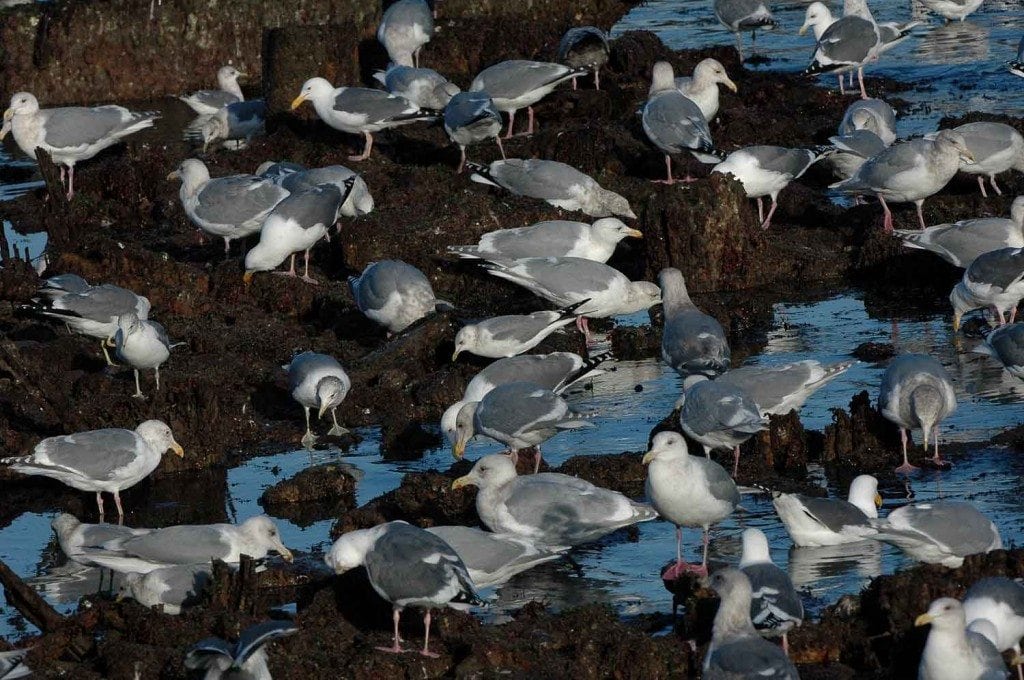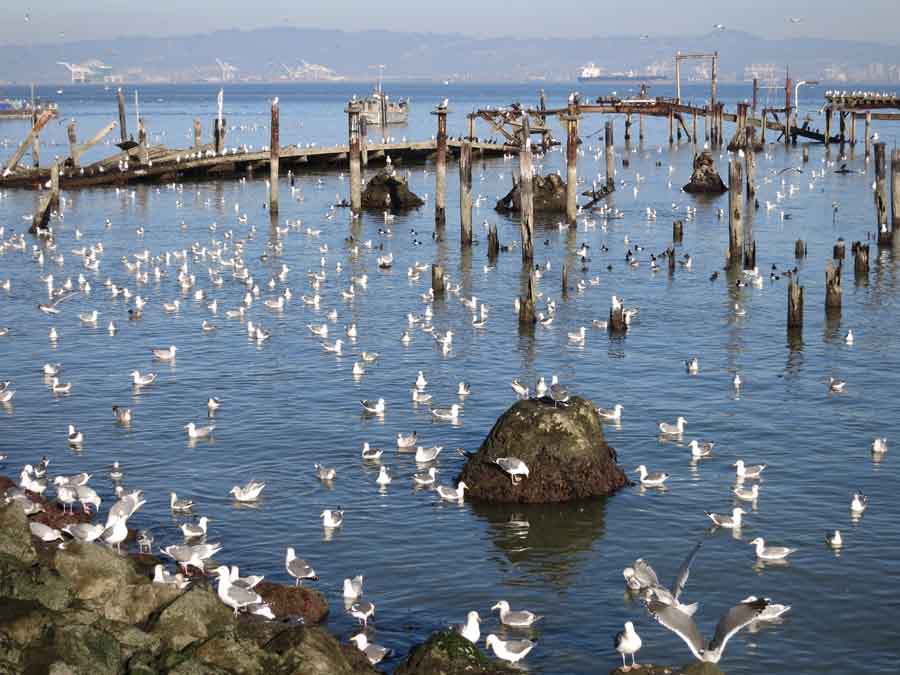Herring! Gulls! Birders!
By Ilana DeBare
Last week saw one of the first big herring runs of the season in San Francisco Bay.
What’s a herring run? It’s a moment when the tides, weather and salinity are just right for herring to spawn in the bay – thousands upon thousands of them.
Which then draws thousands upon thousands of gulls and other birds.
Which then draws – well, maybe not thousands, but dozens of birders and fishermen.
Last week’s herring run took place over two to three days on the southern waterfront of San Francisco, near Mission Bay. Golden Gate Bird Alliance Volunteer Director Noreen Weeden was there and took these photos that give you a sense of the scale:


The herring lay their roe on eelgrass and other plants in shallow Bay waters. Then as the tide recedes, gulls descend and feast on the roe. The eggs that survive become the next generation of herring.
Together with Eddie Bartley, Noreen counted some 1,500 gulls during her two hours there: 350 Mew Gulls, 300 Western Gulls, 250 California Gulls, 80 Herring Gulls, 7 Thayer’s Gulls, 120 Glaucous-winged Gulls, 5 hybrid Western x Glaucous-winged Gulls, and 2 hybrid Herring x Glaucous-winged Gulls.
It’s great to see this kind of a feeding frenzy, not just from a birding point of view but a conservation point of view.
California’s herring population crashed in the early 1990s, due to a combination of over-fishing and challenging weather conditions.
“There had been a Gold Rush in the mid-70s when the state Department of Fish and Wildlife and fishermen were really irresponsible and caught 30 percent of the herring biomass,” said Anna Weinstein, seabird program manager for Audubon California. “By the early 90s, the numbers were down to almost zero and DFW had to close the fishery for a year.”
Now, thanks to better management (including a catch limit of about 5 percent of biomass) and weather, the herring population has largely recovered — allowing big runs like the one last week.
But there are still challenges. For reasons that aren’t entirely clear, there are hardly any older herring left. The schools are made up of young fish that are less robust and lay fewer eggs.
And the rules managing the fishery remain worrisomely weak. “It would be easy for DFW to raise the (catch) quota if prices rise and they come under pressure from fishermen,” Weinstein said.
During the fall, Golden Gate Bird Alliance joined with Audubon California and other conservation groups in a well-researched letter to DFW seeking stronger herring management practices. So far, Weinstein said, the agency’s response seems positive.
A healthy herring population means a good food supply for birds that rely upon them – not just gulls, but scoters, Harlequin Ducks, Black-legged Kittiwakes and more.
What can we as birders do to help herring and the birds that love them?
Supporting GGBA and Audubon California in continued advocacy on behalf of healthy herring populations is one thing. Buying and eating locally-caught herring is another.
It may sound counterintuitive to conserve fish by eating them. But Weinstein says that local consumers can become a kind of “lobby” for fish. Ask your neighborhood fish store to carry local herring.
“Think about salmon,” Weinstein said. “The only reason wild salmon are still around is there’s a constituency for them, pushing to make sure that our rivers are functional enough to provide habitat…. We can harvest some herring, although not more than we should.”
Want to learn more about California’s herring population and the birds they support? Click here to read the letter submitted by Golden Gate Bird Alliance and Audubon California.
You can also see a video of Golden Gate Bird Alliance member Josiah Clark talking about the deluge of gulls during last week’s herring run. Click on http://youtu.be/SImYRyNH0Tg, or see below.
And here’s a video of Anna Weinstein on the scene at the herring run:
Want to witness a herring run yourself? The breeding season here continues from November through March. We should be seeing upcoming runs in more northerly parts of the Bay, such as near Crissy Field and Richardson Bay. Check local birding listservs like the SF Birds Yahoo Group for word-of-mouth about runs.
